Great choice! Your favorites are temporarily saved for this session. Sign in to save them permanently, access them on any device, and receive relevant alerts.
- Sailboat Guide

Tornado Catamaran
Tornado Catamaran is a 20 ′ 0 ″ / 6.1 m catamaran sailboat designed by Reg White and Rodney March and built by Sailcraft Ltd., Marstrom Composite AB, and Windrush Yachts starting in 1966.

Rig and Sails
Auxilary power, accomodations, calculations.
The theoretical maximum speed that a displacement hull can move efficiently through the water is determined by it's waterline length and displacement. It may be unable to reach this speed if the boat is underpowered or heavily loaded, though it may exceed this speed given enough power. Read more.
Classic hull speed formula:
Hull Speed = 1.34 x √LWL
Max Speed/Length ratio = 8.26 ÷ Displacement/Length ratio .311 Hull Speed = Max Speed/Length ratio x √LWL
Sail Area / Displacement Ratio
A measure of the power of the sails relative to the weight of the boat. The higher the number, the higher the performance, but the harder the boat will be to handle. This ratio is a "non-dimensional" value that facilitates comparisons between boats of different types and sizes. Read more.
SA/D = SA ÷ (D ÷ 64) 2/3
- SA : Sail area in square feet, derived by adding the mainsail area to 100% of the foretriangle area (the lateral area above the deck between the mast and the forestay).
- D : Displacement in pounds.
Ballast / Displacement Ratio
A measure of the stability of a boat's hull that suggests how well a monohull will stand up to its sails. The ballast displacement ratio indicates how much of the weight of a boat is placed for maximum stability against capsizing and is an indicator of stiffness and resistance to capsize.
Ballast / Displacement * 100
Displacement / Length Ratio
A measure of the weight of the boat relative to it's length at the waterline. The higher a boat’s D/L ratio, the more easily it will carry a load and the more comfortable its motion will be. The lower a boat's ratio is, the less power it takes to drive the boat to its nominal hull speed or beyond. Read more.
D/L = (D ÷ 2240) ÷ (0.01 x LWL)³
- D: Displacement of the boat in pounds.
- LWL: Waterline length in feet
Comfort Ratio
This ratio assess how quickly and abruptly a boat’s hull reacts to waves in a significant seaway, these being the elements of a boat’s motion most likely to cause seasickness. Read more.
Comfort ratio = D ÷ (.65 x (.7 LWL + .3 LOA) x Beam 1.33 )
- D: Displacement of the boat in pounds
- LOA: Length overall in feet
- Beam: Width of boat at the widest point in feet
Capsize Screening Formula
This formula attempts to indicate whether a given boat might be too wide and light to readily right itself after being overturned in extreme conditions. Read more.
CSV = Beam ÷ ³√(D / 64)
The TORNADO first appeared as winner of the 1967 international “B” class catamaran trials. It was an Olympic class from 1976-2008. The class rules were changed to allow twin trapezes, ‘flat head’ mainsail, and asym. spinnaker.(2004?)
Embed this page on your own website by copying and pasting this code.
- About Sailboat Guide
©2024 Sea Time Tech, LLC
This site is protected by reCAPTCHA and the Google Privacy Policy and Terms of Service apply.

- AMERICA'S CUP
- CLASSIFIEDS
- NEWSLETTERS
- SUBMIT NEWS

The oldest video footage of Tornado catamarans racing
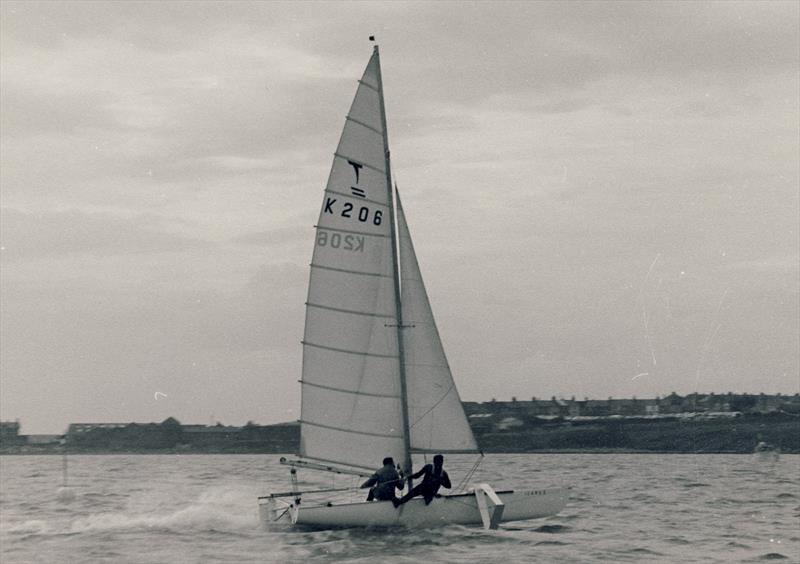
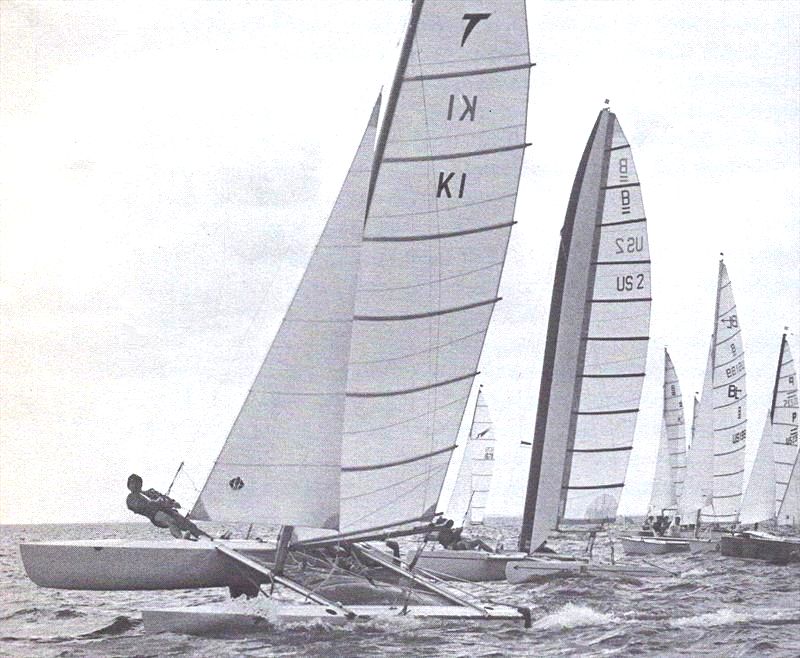
Related Articles
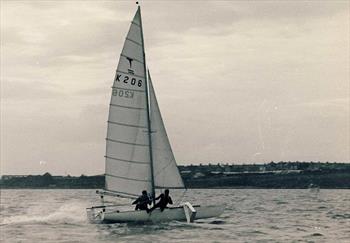
Upcoming Events

- AMERICA'S CUP
- CLASSIFIEDS
- NEWSLETTERS
- SUBMIT NEWS

Tornado catamaran makes its case for Olympic Comeback
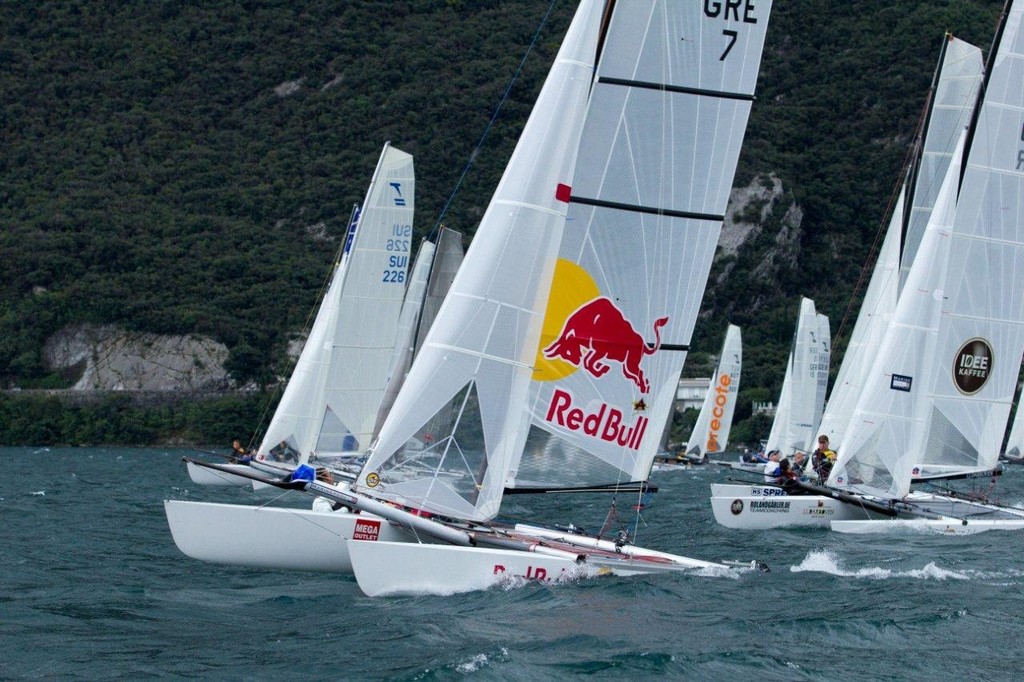
Related Articles
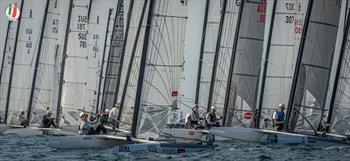
- Yachting World
- Digital Edition

New Tornado rules adopted
- March 2, 2001
The International Tornado class had its rule changes adopted by ISAF yesterday (March 1) writes Hugh Styles. This comes as a monumental step forwards for the class in its 30-year history since being designed by Rodney March in the late 60s. The issue of changing the boat to add twin trapeze spinnaker and a bigger mainsail and jib has been one that as long ago as 1992 there were moves a foot to update the catamarans performance.
In the last year the class has come under increasing pressure from ISAF to conform to the norm in comparison to other high performance cat classes, and add twin trapeze and spinnaker. This was apparent at the Quiberon evaluation event which ISAF ran in March last year to gain an idea of the comparisons between the Tornado and the other F18 and F20 type cats. ISAF came away from the evaluation event determined to push the Tornado towards being more spectacular and high performance. I believe in the first ruling of its type at the November ISAF conference 2000 the Tornado class was pressured into adopting the assigned changes dictated by the ISAF Events committee, in order to maintain its Olympic status. It has taken till March 1 to change the class rules legally in order to ensure that the class maintains its Olympic status for the forthcoming Olympiad.
The position for the Tornado sailors is now one of huge change as a spinnaker system and a whole new development for mainsail and jib are required.
New rig specifications
- Mainsail: 16 sqm (compared to 15sq m) – the main has been made square top with a much larger roach
- Jib: 7.2 sqm (compared to 7 sq m) – this is now permitted to be fully-battened, but has to sheet to the front beam
The rule changes are effective as of March 1 and the next Tornado Olympic class regattas will be raced in the new format. This gives a tight timescale for Olympic crews to carry out development in order to have their boats race ready for the first of the Eurolymp regattas which begin in the early part of April.
I for one am pleased that the changes have been brought about for the next Olympiad as the class was in danger of being left behind. With the F18 and F20 classes continuing to develop a good competitive racing circuit and push their technical development towards the cutting edge of high performance catamaran racing. The new format Tornado (which may have a name change in the near future) will be far more spectacular than before with colourful spinnakers which will improve the boats performance downwind, to make it comparable around the race track to a 49er, if not faster! Upwind the extra trapeze should make the boat faster, and will also add new dynamics to the crew work onboard the vessel. This can only bode well for the class, as it provide new challenges for sailors and my feeling is that it will also entice many top quality sailors from a variety of other different classes into the fray.
For Team Styles and May a great deal of boat development is now the order of the day so as to ensure that we have the systems onboard the boat are working effectively for the start of the season, in April. Holt are working closely with us to develop specific systems and fittings that will match the new requirements for the big rig Tornado. On a similar front Marlow ropes are also developing ropes specifically adapted to cope with the high working loads encountered on the Tornado, they are also using the our Tornado as a test bed for research and development of some of their new hi-tech ropes.
Both Adam and I are looking forwards to the challenges that the new rig brings, it will be more exciting and challenging to sail and at least for the first few outings much more entertaining for spectators to watch as I try to helm from the trapeze. I am sure that there may be a few swimming sessions as we learn how hard we can push things when sailing in
Browse by Category
- Coach of the Year
- High School Sailing Team of the Year
- Optimist Sailor of the Year
- Sailing Fitness
- Regatta News/Results
- Boat Speed/Tuning/Sailtrim Articles
- General Sailing News
- Coaches Locker Room
- From the Experts
- Profiles in Pro Sailing
- Featured Jobs
- Marketplace Ads
- Skip to primary navigation
- Skip to main content
- Skip to primary sidebar
- Skip to footer
Sail1Design
First Name*
Email Address*
November 30, 1999 by Sail1Design Editor Leave a Comment
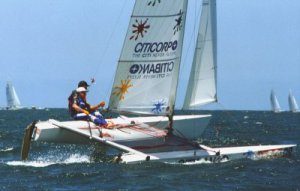
The Tornado was designed in the autumn of 1967 by Rodney March from England, with help from Terry Pierce, and Reg White, specifically for the purpose of being the new Olympic Catamaran, which was to be selected by the IYRU in an Olympic Catamaran Trials. The boat was developed mainly in Brightlingsea, England.
International Status was granted to the Tornado as a result of its outright winning of the IYRU Trials held in England. The next step, adding the Catamaran event to the Olympic program, occurred two years later, with the result that the first Catamaran event, sailed in 1976 in Canada, was sailed in the Tornado. The Tornado is an outstanding example of a class that was designed specifically for Olympic competition that has become a successful International class on its own merits.
2000 Olympic Silver Medalists: Darren Bundock and John Forbes (AUS)The Tornado has since remained unchallenged as the ultimate one-design catamaran. With its modern, stylish rigging and sleek lines the Tornado is quick to catch the eye of any water-drawn on-looker as it speeds across harbors, lakes, and oceans in over 30 countries around the world. With its ability to reach speeds of 15-18 knots upwind and downwind, and 33+ knots reaching, the Tornado is truly the purists’ speed machine.
Over 4,800 Tornados have been built, with 1,200 class association members worldwide. In 2004, on the Saronikos Gulf in Greece, the Tornado will be sailing in its seventh Olympic Games.
Except for refinements in technical details – improvements in hull, sail, and spar technology, better blocks and lines – the Tornado was unchanged from its beginnings in to the early 90’s. Then, as a result of the increasing popularity of other, smaller catamarans, the Tornado class undertook a major development program in 1993. It was specifically to respond to a request from the IYRU to search for ways to improve the public and media awareness of the sport of yachting, and secondarily to answer the possible challengers to its ‘top cat’ role.
Two weeks of intensive on-the-water testing and development took place in Miami, following considerable discussion and planning. Among the participants were the three medalists from Barcelona as well as designer Reg White. The International Tornado Association spent nearly US$22,000 on the testing, evaluation, reporting, and finally balloting process to the class membership, to find the fairest and best ways to improve the class and the sport in ways acceptable to the sailors.
The testing involved 10 standard and fully competitive Tornados, one boat with a larger main and jib, and two boats with a variety of sailplans that included spinnakers of up to 32 sq. M. Fourteen races were run over the testing period in addition to in-line speed and handling evaluations.
As part of the testing process, new courses were also used, most involving a leeward gate.
Following the testing and regatta, the following points were clear; the larger main/jib combination was only marginally faster than the standard rig, and the spinnaker boats were a surprise, only beating the standard rigs in 2 of the 14 races. The ITA then balloted the class membership, with not only the conclusions but also all of the data and the testing procedure, helping to provide insights to the rig selection process.
A two-thirds majority is required by the class constitution to implement any change; this majority was not reached, the class voting against the expense of a change with no real benefit to sailing. Thus the class retained the same sailplan for the next two Olympics. The course changes, giving the possiblity of better spectator access and greater media coverage, received the votes necessary to be adopted by the class.
The Class felt then that the changes in course, rather than changes in the equipment, would have a greater impact on public awareness and media coverage. Courses are adjustable in length for wind, thus giving a fixed racing time for the event, and the shorter-than-before course also tend to keep the boats closer, making the racing more exciting and more easily viewed. The fixed Start/Finish lines also is a help, allowing faster turn-around times between races. The new course formats have been in use in the World Championship beginning in ’93, and have proven popular with both the sailors and committees, and are continued today.
The issue of changes in the boat were revisited in 1999, when the ISAF decided to have a Multihull Evaluation Trials in France to look at “possible replacements” in the Olympic program for the Tornado. At the time, there were a number of technical changes in materials that allowed for better spinnakers, and better control, and there were then a number of successful double-trapeze plus spinnaker catamarans on the market in the Tornado size range – 20 feet – that were becoming popular.
The Trials were interesting. Except for the custom, all-carbon Marstrom 20, the standard Tornado dominated upwind, beating all production challengers from Hobie, Nacra, Mystere, and others. Only by piling on sail area, plus a spinnaker, were any of the challengers able to beat the Tornado around the race course, and even then the advantage disappeared as the wind increased. But the extra athleticism needed to sail with a double trapeze, and the extra visual interest provided by the spinnakers, was undeniable, and the final outcome was that the ISAF decreed that the equipment for the 2004 Olympics would be the “Tornado with double trapeze and spinnaker”, and left it up to the class how to implement the changes.
The class took an approach that allowed some development and testing, with the goal of keeping crew weight in the same range as with the old rig. The final result, approved by the class in early 2001, were both evolutionary and radical. First was a new mainsail with a flat top and more area, providing more heeling moment to compensate for the double instead of single trapeze and help keep crew weights with the same range. Second, done to clear the trampoline to make spinnaker work possible, was to redesign the jib. The new jib had the same area, but was longer on the luff and shorter on the foot to allow it to be sheeted to the main beam. Interestingly, this change, moving the sail area forward, overcame one of the Tornado’s handicaps, tacking, and made this maneuver much easier. The innovation of a self-tacking jib appeared later in 2001, and was quickly adopted by the entire fleet. Finally, of course, there was the spinnaker, and the class set only size limits, allowing the question of spinnaker handling equipment to be settled on the race course. Again, the advantages of spinnaker launching tubes quickly established themselves, and became a class standard. Interestingly, the two biggest boathandling improvements, the self-tacking jib and the spinnaker tubes, were quickly adopted by the classes below the Tornado, especially the International Formula 18, which was becoming the Tornado trainer for future Olympians.
Class website: http://www.tornado.org/
Reader Interactions
Leave a reply cancel reply.
Your email address will not be published. Required fields are marked *
By submitting this form, you accept the Mollom privacy policy .

One Design Classes
Browse the airwaves.
- Sailing News Articles
- High School & College News Articles
- One-Design Class Profiles
- Tactics & Strategy
- Sailing & Education
- ICSA Rankings
- Sailing/Yacht Club Profiles
- Youth Sailor of the Year
- Sail1Design Annual Awards
Helpful Links
- Join the S1D Team
- Accessibility Help
- Privacy Policy
- Entries feed
- Comments feed
- WordPress.org
Log in or Sign up
You are using an out of date browser. It may not display this or other websites correctly. You should upgrade or use an alternative browser .
Tornado class plans
Discussion in ' Multihulls ' started by corsaro , Mar 1, 2007 .
corsaro Junior Member
Hallo, I'm new in this forum, Sorry for my english My question is: There is a plan of tornado class catamaran for home builder? thanks
joz Senior Member
corsaro said: ↑ Hallo, I'm new in this forum, Sorry for my english My question is: There is a plan of tornado class catamaran for home builder? thanks Click to expand...
Chris Ostlind Previous Member
Yes, There are free plans Corsaro, You can find a full set of building plans for the Tornado at this link: http://www.thebeachcats.com/modules.php?op=modload&name=Downloads&file=index&req=viewdownload&cid=6 This is a 16.8 Mb download with photos and full, dimensioned drawings so have fun. Below are a couple of pages from the package as a sample. Chris Ostlind
Attached Files:
Construction_notes_deck_beam_and_stringers_sized.jpg, photos5_8_sized.jpg.
Roy Reroma New Member
Hi!!! I'm new to the group...from the Phils. I was able to but a plan from a fellow member in the yahoo group. It consist of a booklet and blue prints. Most of the pages shown on thebeachcats site are scanned copies of the booklet. Am not sure what the current copyright of this plan but the guy I bought it from said he has never built a boat. So I don't know whether I can make copies.
TTS Senior Member
You will also find Tornado plans availble through Gougen Brothers/West System Epoxy. You can either get lines to build using cold molded or plans for tortured plywood construction. Mine is built with the later and it was a six month project from initial planning to completion and launch. It was not that difficult to build and measured in class legal. Mine was 8 pounds over minimun class weight and had I been a little more delicate with the epoxy saturation in the glass and keel it probably would have been below minimum weight. It is still sailing hard 19 years later.
Rolf Nilsen Junior Member
The plans on thebeachcats site are the early Jerry Houlton plans and some russian plans. Jerry bought some moulds for cold moulding from Gougeon bros. after and while and stopped doing tortured ply T's. The plans are a collective work and not copyrighted as far as is known. The copyright holder to the russian plans have consented to making the plans available. You can buy Tornado building plans from ISAF, but the sets available on thebeachcats are superior. The measuring templates for the Tornado on the other hand are copyrighted.. If you build a Tornado, you must pay a building fee to the International Tornado association which again pay a fee or used to pay a fee to the designer, Rodney Marsh. I always heard that the Gougeon cold moulded boats with their internal truss framwork was very stiff. I have a friend with a Gougeon boat, but it has gone overweight and still have the old softish crossbeams so it's hard to compare with Marstrom boats. In their day the Gougeon boats where the boats to beat, but that changed with Marstroms boats as it was rumours that it was faster in a chop. Just rumours, but still enough to kill off the wooden boats. Marstroms tornados sell for US$32.000,- ex. VAT and shipping.. Homebuilding for local racing should be a good option if you have the time and a fleet nearby. Buying an old, used, Tornado would be a lot cheaper than homebuilding and buying all the gear new. Alu Tornado masts are found all over the place these days, I have secured two for myself.. TTS, what kind of beams do you have on your boat, and how stiff is it compared to Marstroms? And by the way, I have heard about the Gougeon cedar tornados and plywood tornados, but no strip plank tornados. Why not? Should be stiffer and potentially lighter if built that way?
Rolf, I think there are two reason for not seeing strip planked tornados out there and possibly more. To build a strip planked hull you will need to loft out the lines, set up bulkheads and build on top of those. It is a much more time consuming process than cold molding was if you were building more than a one off boat. The plywood construction, though limited by the constraints of shaping the hull, was easy, fast, efficient and if done correctly measured in. It also produced very stiff hulls. Probably not as stiff as the Houlton hull, but stiifer than the old Sailcrafts and reg Whites and much stiffer than the Panthercraft hulls. I have Sailcraft of canada beams on my boat and feel that the hulls themselves are close to as stiff as Marstrom hulls, but the beams are not anywhere near as stiff, so I probably have more hull walk then Marstroms do. I have always thought it a shame, that with the advent of composite hulls, that the cold molded boats faded away. I have sailed on the folloing T's. Panthercraft, Sailcraft of canada, Reg White, Marstrom, Mark Lindsay, Gougeon, Houlton, Yankee Laminates, a German & Australian boat (do not know the builders) and quite a few home built from glass/foam/glass to wooden ones. Some have measured in and others did not. Most of the wood or plywood where very stiff hulls, it was the beams and beam boxes that sometimes showed the difference. The other thing that I think that Marstrom got right was the shape. Their boats were faster than the other production boats so Sailcraft closed, Reg White moved on and Paul Stanley of Yankee Laminates could not get sailors to give him a chance. His boats were extremely well built at Concordia yatchs in South Dartmouth, MA. He had done a couple of things differently than Marstrom had and in hindsight he may not have made those chooses. He pushed the freeboard in the bows to the maximum and pushed the flaired the bows at the deck line out to the max as well. With some of the current thoughts in design, he might have gone for a narrower/finer entry. I would like to see at least one or two more builders make headway in the market, but who knows. do you know what is happening with Graham Eeles? Anyway, rolf those are my thoughts.
And back to the other thought, strip planking. I built a 40' tri (Skyhook" Chris White design, out of Western red Cedar, strip planked. I do not know if you could have gotten the weight down enough in that process to make the boat at or below class minimum. It would be an extremely stiff shell, but I think that you would be working with 3mm strips which would almost be like full scale model making and then inner and outer glass skins. If you were not all the way up there in Norway and over here, I would attempt that project with you.
Thanks for the nice reply. I also think wood an excellent material which I would like to see more boats made of. Carbon/nomex/foam is very stiff, but wood.. sight.. If the stations was set up correctly for stripping, a builder would not have the uncertainty stressed or tortured ply brings with regards to measuring in and eventual cracks. But what I am really asking for is how 'stiff' in practical sailing a strip planked hull would be compared to glassed ply. I agree that the beams and beam seats are more important for hull walk, but it would be fun to compare with a Marstrom. 4mm strips are used in stripper kayaks and canoes. Easy to work with and probably sands down to about 3.5mm. The Gougeon book also say that panel stiffness is very good compared to plywood. So, would a stripper Tornado be as stiff and light as a Marstrom if beams and beam seats were of comparable quality We are about to commence with no less than three F-16s in strip, so opinions and comments is highly interesting.
I honestly think that compared to glass/foam/glass that glass/wood/glass is stiffer and stronger. Keep me posted with the details of the three F-16's that you are building. i would be very interested to see how they develop. Again, my feeling is that if the shape can be gotten down correctly and the weight does not become an issue, I would rather have a wood (marstrom) than a glass one.
To stop weight from becoming a problem epoxy would have to be kept to a minimum. Instead of a plain weave or satin/crowfoot weave, unidirectional glass would be preferable. But as always when homebuilding, it depends on the budget and what can be sourced. I dont know how the Eeles Tornado does. It has been very quiet about that boat lately, perhaps becouse Barney and Walsh have not peaked with it? They finished 16th at the worlds in Cascais recently, but I dont know if they used the Eeles boat. I plan on posting regularly about the F-16 project in my blog, so it will be easy following it.
Pericles Senior Member
Here are a few Tornado websites. http://www.grahameeles.com/ http://www.sailing.org/default.asp?...x5Y12y/MmuuoofDl`9oICJY6/20C,BCxWSG134b0WRNga http://www.swell-catamarans.co.uk/contact/index.html http://www.spitfiresailing.org.uk/data/BSCA class rules.pdf Pericles
Here goes Tom.. Sorry for bringing an old thread to back to life! Just tought I should let you know that the Blade F-16 project I mentioned now is underways. Will be very interesting to find out what the weight of the finished hull comes down to! There is a blog we update after each building session at: http://woodastic.blogspot.com/
TORNADOCAT63 New Member
- Advertisement:

Old Tornado class rules
Plywood Tornado US21 Hull Repair
Small trimaran with tornado/nacra 5.8 center hull.
Question on Tornado hull side plan
Tornado sailplan
Tornado catamaran tilt trailers could one be adapted to carry a 14' beam trimaran?
Tornado hull modifications
Scale up a Tornado for Round the World Non Stop
Protoype wing rig on artemis test tornado catamaran.
Trimaran From a Tornado Cat
- No, create an account now.
- Yes, my password is:
- Forgot your password?


By Product Categories
Small Boat Blocks
Big Boat Blocks
Complementary Hardware
Travelers & Genoa Leads
Mainsail Handling
Headsail Handling
Mooring Solutions
Spare Parts
Accessories
Harken Canvas
Sportfishing
Fly Soft-Attach Blocks
Carbo Air Blocks
Small Boat Classic
Flip-Flop Small Boat
GP Catamaran Ceramic Mainsheet Systems
Protexit™ Exit Blocks
Through-Deck
Wire High-Strength
Dinghy Vang
Small Boat Deck Organizers
Midrange Classic
Midrange Deck Organizers
Zircon Blocks
Element Blocks
Black Magic Air Blocks
Cruising ESP Blocks
Megayacht Blocks
Stainless Steel Blocks
Black Magic Air Runners
FlatWinder Powered Blocks
Mastbase Blocks
Over-the-Top
Crossover Blocks
Big Boat Deck Organizers
Cam Cleats & Kits
Cam Cleat Accessories
Cam Cleat Bases
Stand-Up Bases
Deck Organizers
Spinnaker Pole Cars
Soft Attachments
Fixed Padeyes
Removable Padeyes
Bolt-Down Fairleads
Grand Prix Jib Leads
Halyard Tensioners
Tiller Extensions
Peter's Desk Drawer
Dinghy Jib Leads
Crossbow Pivoting Self-Tacking Jib Traveler
13 mm Micro
22 mm Small Boat
27 mm Midrange
32 mm Big Boat
Windward Sheeting
42 mm Mini-Maxi
T-Track Genoa Lead
Access Rail System
13 mm AA Battcar System
22 mm A Battcar System
27 mm B Battcar System
32 mm C Battcar System
18 mm Switch Battcar System
26 mm Switch Battcar System
26 mm Trysail Switch
32 mm Switch Battcar System
32 mm Trysail Switch
40 mm Switch Battcar System
40 mm Trysail Switch System
Furling Mainsail Outhaul Systems
Single Line Reefing
Harken Vang-Master
Carbo Racing Foil
Small Boat Furling
Small Boat Underdeck
Reflex Furling
MKIV Jib Reefing & Furling
MKIV Underdeck Jib Reefing & Furling
Furling Accessories
Powered Furling
MKIV Ocean Furling
SnubbAir (Not a Winch)
Grand Prix Winches
Air Winches
Circuit Breakers
Analog Switches
Digital System Switch
Aluminum, Chrome & Bronze Winch Handles
Carbo OneTouch Locking Winch Handle
Service Kits
CLR Mooring Winches
Electric Captive Reel Winches
Hydraulic Captive Reel Winches
UniPower Radial
Single-Acting Integral Backstay Adjuster
Single-Acting Cylinders
Locking Cylinders
Double-Pull Cylinders
Grand Prix Cylinders
Hydraulic Cylinder Rod End Blocks
Hydraulic Cylinder End Fittings
Control Valves
Control Manifolds
Control Panels
Compact Control Panel
Rotary Pumps
Hydraulic Pump Handles
Power Systems
Repair Kits
Ball Bearings
Block Spare Parts
Traveler Cars
Furling Spare Parts
Winch Spare Parts
Winch Service Kits
Blockheads Gear
Promo & Gifts
Marine Grip
Blue Performance
Jeep/Truck tops
Garage storage
One-design Covers
Boat accessories
Canvas bags
By Type of Sailing
Dinghy / One-Design
Offshore Racing
Coastal / Day Cruising
Bluewater Cruising
Megayachts / Custom
Service Guide
Tech/Service
deck layouts
Data Sheets (SDS)
How to choose
System diagrams
Calculators
Reeving diagrams
Traveler Purchase Selection Guide
How to Choose
Testimonials
Hoister Videos
Request a Quote
Request Samples
Fabric details
Cover Styles
Canvas Videos
Contract Services
Materials and Components
Our Equipment
Contract Cut-and-Sew Project Spotlight
- Harken at the front
- Safety & Rescue
Support / One-design deck layouts
Tornado Deck Layout

10:1 Carbo Mainsheet System
Tornado mainsheet systems can be installed inside the boom or mounted externally. Internal 9:1 cascaded systems work, but problems are difficult to fix. Most sailors prefer a 10:1 external non-cascaded system because it's easily accessible and jam-ups can be fixed on the fly.

Cunningham,16:1 Double-Ended
The trimmer can play this powerful double-ended system from either side of the boat, tensioning hard upwind for boatspeed or easing for offwind power.
Self-Tacking Jib, Cascaded 4:1
The 4:1 self-tacking jib provides simplified boat handling, allowing crew additional time for fast wire-to-wire tacking. Upwind in light air, the traveler car is positioned near the middle of the track. As the wind builds, the car is eased to maintain speed and stability. Downwind, the trimmer plays the sheet to adjust sail shape.

2:1 Mainsheet Traveler
This simple system features a split line that dead-ends on two eyestraps to create one control line that brings the car to the center of the traveler track from either side of the hull.
If you would like to link to or reprint this article please contact [email protected]
Class History
Designed in the UK by Rodney March, the 20-foot-long Tornado was developed in 1966 as the Olympic catamaran for the '76 Games in Kingston, Ontario. Its two long hulls and 25.2 m square (272 sq. ft)of sail area allow it to accelerate to hair-raising speeds of 15-20 knots, making it the fastest of the Olympic-class boats. With the recent addition of double trapezes, a 25 m sq.(270 sq. ft.)asymmetrical spinnaker, and carbon rigs, the turbo-charged Tornado carries a crew of two at offwind speeds of up to 30 knots. Known for its innovative one-design racing, the Tornado has long been considered an almost perfect boat.
Links International Tornado Class McLube™
Boat Specifications
Length: 6.10 m, 20 ft Width: 3.05 m, 9.9 ft Main & Jib: 24 sq. m, 28.7 sq. yds Gennaker: 25 sq. m, 30 sq. yds

Related products

22mm High-Load 1250 Car — Fixed Sheaves, Eyestrap

16mm Double Block

22mm Low-Beam Track — 3 m

29mm Cheek Block

40mm Block — Swivel, Becket

5mm Twist Shackle

57mm Triple Ratchet Block — Swivel, 40 mm Side Carbos, Cam Cleat

22mm Car — Pivoting Shackle

Micro Cam-Matic® Cleat

22mm Endstops — Low-Beam, Set of 2

Micro Cam Base — Swivel, 16 mm Sheaves
Product categories.
- United States
- New Zealand
- United Kingdom
Harken will be closed on Thursday, Sep. 12 starting at 11 a.m. for our annual Sail Day. Any orders placed after 3 p.m. Wednesday, Sep. 11 will be processed on Friday.

IMAGES
VIDEO
COMMENTS
The Tornado was designed in 1967 by Rodney March from the Isle of Sheppey, England, specifically to be the Olympic Class catamaran. It easily defeated the other challengers in a selection event in England in the same year, and sailed its first Olympics in 1976.
The Class. The Tornado was designed in 1967 by Rodney March from the Isle of Sheppey, England, specifically to be the Olympic Class catamaran. It easily defeated the other challengers in a selection event in England in the same year, and sailed its first Olympics in 1976. Since then, with constant refinement of underwater shapes, construction ...
The Tornado is a double handed multihull class recognised as an International Class by the International Sailing Federation. It was used for the Catamaran discipline at the Olympic Games from 1976 to 2008. Design. One hull flying. The boat was designed in 1967 by Rodney March from the Isle of Sheppey, England.
1997-2003A Brief Tornado History. The Tornado was designed in the autumn of 1967 by Rodney March from England, with help from Terry Pierce, and Reg White, specifically for the purpose of being the new Olympic Catamaran, which was to be selected by the IYRU in an Olympic Catamaran Trials. The boat was developed mainly in Brightlingsea, England.
The TORNADO first appeared as winner of the 1967 international "B" class catamaran trials. It was an Olympic class from 1976-2008. The class rules were changed to allow twin trapezes, 'flat head' mainsail, and asym. spinnaker.(2004?)
The Tornado catamaran was for many years the fastest Olympic sailing class and was the first catamaran to be introduced to the Olympic Games. It was first sailed in the 1976 Olympic Games and saw ...
Posted on 12 May Oldest videos of racing catamarans We start in 1965, covering Hobie, Shearwater, Prindle and C Class, then the Worrell 1000 ... Tauranga took its place as the home of the Tornado class, winning the top four overall Posted on 13 Apr 2022 2021 Tornado Worlds at Thessaloniki, Greece
Latest news and videos from the International Tornado Multihull Sailing Class.
Tornado Catamaran is a 20′ 0″ / 6.1 m catamaran sailboat designed by Reg White and Rodney March and built by Sailcraft Ltd., Marstrom Composite AB, and Windrush Yachts starting in 1966. ... The TORNADO first appeared as winner of the 1967 international "B" class catamaran trials. It was an Olympic class from 1976-2008. The class rules ...
International Tornado Class Association. 3,678 likes · 236 talking about this. The ITA is the overarching body for Tornado sailing around the world. Check out our website www.tornado-class.org. International Tornado Class Association. 3,678 likes · 236 talking about this. ...
The Tornado Olympic Catamaran has a 30 plus year history, beginning with its inception in 1967 and continuing through to the present day as a legendary sailing vessel. 1967. The Tornado was designed in 1967 by Rodney March, Terry Pierce, and Reg White in England specifically for Olympic catamaran competition. It gained international recognition ...
We start in 1965, covering Hobie, Shearwater, Prindle and C Class, then the Worrell 1000 We delve into the past, and round-up all the videos which show racing catamarans, including Hobie cats, Shearwaters, Prindles and C Class, from the 1960s to the 90s. Plus some Worrell 1000 history. Posted on 7 Apr UK Tornado Nationals 2023 at Minnis Bay
The Tornado Class invented the Volvo Champions Race with their spectator and media friendly short course racing. The newest invention is the Speedsailing race format www.speedsailing.org. The aim of this fresh approach to sailing is to breathe new life into the sport and bring the skills and thrills of Tornado catamaran racing to a wider ...
The Tornado Sport with double trap, sq top main, self tacking jib, & spinnaker obsoleted all the old classics with two sails. Portsmouth # of Sport is 59 similar to F-18's, N-20. ... Offering sails and other go fast parts for A-class catamarans-- Go to page 1 - 2 : Quick reply. No HTML tags allowed (except inside [code][/code] tags) ...
Aaron McIntosh and Bruce Kendall enjoy the pure sailing pleasure of the Tornado Catamaran. Video footage was shot by Heletranz in Auckland 2006.
The International Tornado class had its rule changes adopted by ISAF yesterday (March 1) writes Hugh Styles. This comes as a monumental step forwards for the class in its 30-year history since ...
The two centreboards shall be fitted in the centreboard cases, one in each hull. The two rudders shall be hung on the transoms, one on each transom. The rudder retention devices shall retain the rudders, in the event of capsize. The rudders shall, when fore/aft, be in the centre plane of each hull. C.9. C.9.1.
The Tornado is an outstanding example of a class that was designed specifically for Olympic competition that has become a successful International class on its own merits. 2000 Olympic Silver Medalists: Darren Bundock and John Forbes (AUS)The Tornado has since remained unchallenged as the ultimate one-design catamaran.
Just rumours, but still enough to kill off the wooden boats. Marstroms tornados sell for US$32.000,- ex. VAT and shipping.. Homebuilding for local racing should be a good option if you have the time and a fleet nearby. Buying an old, used, Tornado would be a lot cheaper than homebuilding and buying all the gear new.
Class History Designed in the UK by Rodney March, the 20-foot-long Tornado was developed in 1966 as the Olympic catamaran for the '76 Games in Kingston, Ontario. Its two long hulls and 25.2 m square (272 sq. ft)of sail area allow it to accelerate to hair-raising speeds of 15-20 knots, making it the fastest of the Olympic-class boats. With the recent addition of double trapezes, a 25 m sq.(270 ...
Silver. Bronze. 2023. Dervio (ITA) 30 Boats. Yoann Trécul (FRA) Thomas Ferrand (FRA) Kohlendorfer Angelika (AUT) Calvin Claus (AUT)
The Tornado class catamaran is a high performance yacht sailed by a crew of two people. Designed in 1966 by Rodney March, the Tornado almost instantly became an international class. The Tornado ...
The latest Tornado catamaran photos from the International Tornado Class [srizonfbgallery id=1]